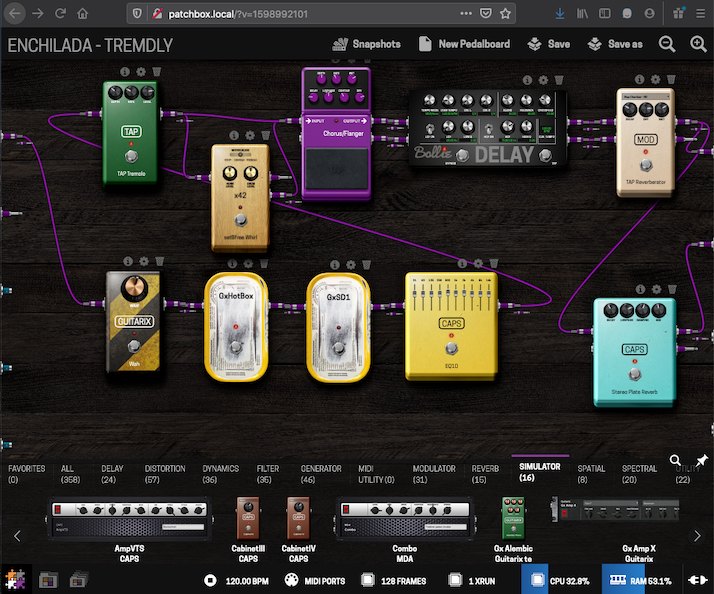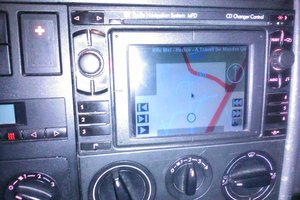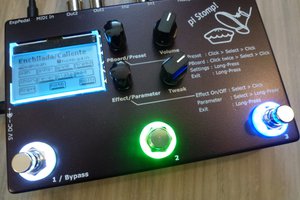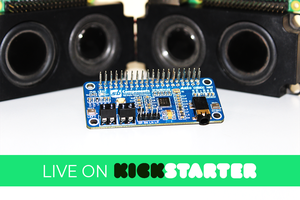pi-Stomp Core Hardware Specs:
- Raspberry Pi 1.4 Ghz 64-bit quad-core processor
- Dual ins/outs, 24-bit, 48 to 96kHz stereo audio (AudioInjector Zero, HiFiBerry, etc.)
- Latency: 2.67ms (128 frames/96kHz). 5.33ms if CPU load is reduced by changing sample rate to 48kHz or frames to 256.
- Buffered Input Impedance: 1 Meg Ohm
- True bypass on In1/Out1 via latching relay
- Stereo output Volume control
- Encoder for navigation and control
- Header to support most SPI based LCD/LED displays
- ADC with header for adding up to 8 Analog controls (pots, faders, expression pedal, switches, etc.)
- Debounce with header for up to 5 momentary switches (footswitches, pushbutton, etc.)
- UART header for serial communication or DIN MIDI In/Out (optional $12 module)
- Header for 3 uncommitted GPIO pins for whatever (ins/outs, sensors, LED's, etc.)
- USB MIDI support via Raspberry pi USB port
- Small footprint! A System with color TFT LCD, three footswitches, and
two assignable tweak knobs fits in a Hammond 1590J enclosure: 145mm x 95 x 45 (5.7in x 3.7 x 1.9) - Low cost: Board + components + raspberry pi + audio card + color TFT LCD
+ power supply, should cost about $160. Add a few footswitches, knobs, a an enclosure, etc. and you're likely still to be spending less than $200.
The Software
All pi-Stomp software and firmware is open source. The heart of the system is MOD Host and MOD UI from moddevices.com. Mod Host is the audio host. Once you install all the software on the pi-Stomp, it will serve over wifi the MOD UI webapp which you use to configure your virtual pedalboards via a browser on your computer.

It's a drag-n-drop interface. Select from over 350 effects, models and synths. Create as many pedalboards as you like. They are stored on the micro SD card in the pi-Stomp. So once your done editing you can use your pi-Stomp stand-alone driving it via the LCD and encoder knob.
The LCD shows the current pedalboard, preset, set of plugins and controller assignments. Scrolling thru the various elements then "clicking" (pushing down on the encoder) allows for deeper editing of effect parameters or system settings.
Controlling pi-Stomp
Attached footswitches can be configured to control the relay bypass or increment/decrement the preset/snapshot of the current pedalboard.
The plugins included in the current pedalboard can be controlled by assigning plugin parameters (via "MIDI learn" in the MOD UI) to hardware controls including:
- Attached footswitches, pushbuttons or toggles
- Attached knobs, faders or expression pedals
- An external MIDI controller via the USB port
- An external MIDI controller via an optional DIN midi module
- Phone or tablet app via touchosc over wifi
Building pi-Stomp Core
pi-Stomp Core kits from treefallsound.com contain everything needed for a functioning system: pi-Stomp Core circuit board, all parts, Raspberry pi, audio card, LCD, knobs, power supply, etc. It does not include footswitches, tweak pots, an enclosure etc. because those details are left to you to decide.
Super detailed build instructions are provided. You'll need to solder about 30 parts to the circuit board and assemble the core stack. Assuming your soldering skills are decent, this should take from 1.5 to 3 hours... Then you'll download/install the software which takes another half hour. If all goes well, you should be able to plug in and play. You'll likely want to add some controls (footswitches, tweak knobs, expression pedal, MIDI, etc.) and mount in an enclosure. Since all controls can be attached with simple jumpers, you can try things out before deciding upon your final design.
See the pi-Stomp Core Wiki for customization and enclosure suggestions.


 Robert Pohlink
Robert Pohlink
 Lithium ION
Lithium ION

The boards ready and tested. Orders can be placed on treefallsound.com. Just waiting for a few parts but kits will be shipping by the first week in September.